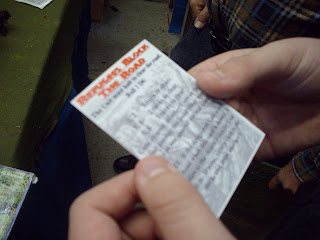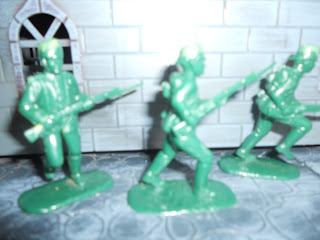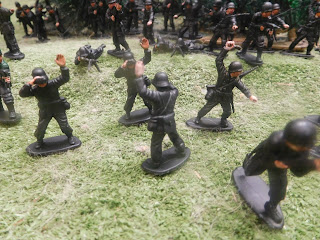The Invasion of Gerolstein Game Mechanics
Many of you will be aware of the Funny Little Wars Yahoo group and the rules book published written by Paul Wright. There is also Patrick Wilson's involvement and his merchandise site, The Virtual Armchair General. The latter sells 54mm figures for FLW, the FLW book and accessories, including chance card sets. The FLW chance cards were used in my recent game. Most of the flags are also from Patrick.
The Gerolstein game was set up on three tables, table tennis sized and larger. The intervening gaps were designated rivers, inlet or sea. The location was my games/rumpus room and linked garage. You will know from some glimpses of background that the garage also hosts my chaotic work bench and assorted junk. By the way, the Thompson sub machine gun on the wall is a toy I had from childhood in the 60s. It used to make machine gun sounds when batteries were used.
Each of the three sides had a command section of territory featuring a fort. I commanded Bluesia (based on France). Mat commanded Gerolstein, which is a small Germanic independent Duchy (based on a comic opera) and his younger brother, Ryan, commanded the Hermans/Army Black, based on Germany, particularly Prussia.
On each table one to three additional territories were numbered with dice and then each player rolled to see what territories he commanded. Mat gained the most initial territories - four, Ryan two and I had two. Each player then used blank cards to indicate disposition of forces. A number of the cards could be left blank to trick the enemy. At least one unit had to be in each territory and two in the headquarters territory.
Each player also wrote his commands on paper and we all put them in a jar. If any commander wished to change the commands a courier had to take them to the sub commanders, in this case figures of brigade leaders. As it happened we all kept to our plans so this was not necessary.
Below: The Bluesian commander, Pepe Costeau, takes aim from his fort with a matchstick firing cannon behind the 'dummy' non-firing cannon.
Mat, the Gerolsteiner commander, General Boom.
Ryan, the Herman commander, during a pensive moment.
I succeeded in keeping fresh Herman forces from crossing to the middle table and in this I was aided by the Grand Fenwick archers holding up the Hermans! I also nearly completed my plan of eradicating other players forces from the middle table. I captured the remnants of two Herman regiments but the third was installed in a building (formerly from Sesame Street!) I had thoughtfully suggested to Ryan that he should open the door to enable him to have more troops shooting out. In my move I was going to rush up my infantry to melee with the occupiers but the torrential rain chance card slowed me right down.
The FLW chance cards from the Armchair General provided a few laughs. Firstly, refugees appeared to clog the roads, which prevented Gerolsteiner forces from getting to the River Blinx to cross to the middle table. Another card gave my men great confidence - singing and cheering- to enhance their movement, only to be neutralized by the 'deluge' card. We rolled from turn two, a one or two result meaning a card was drawn.
The Bluesian Army's major advantage was that field artillery could fire three times. This proved deadly, especially as I ensured effective fields of fire.
The Hermans advantages included extra machine guns and excellent staff officers who could bolster morale exceptionally. Unfortunately for Ryan he didn't get to use the latter and his machine guns were confined to one table where their damage inflicted to others was limited.
The Gerolsteiners ended up with the most troops and most of these fired as elites (+1). They also left bottles of wine laying around in their sections of the battlefield to slow down the enemy. Whenever enemy troops entered their territory a dicerolled result of one or two would mean the unit was affected and would have to roll again for the result. Only one unit succumbed - one of my zouave units - and it became... braver! This gave it a +3 in a melee. So this 'advantage' became a liability to the Gerolsteiners. Another advantage was made by chance and that was that the Gerolsteiners occupied more land at the start of the game.
RULES
Although we use the FLW rules, which are themselves adaptations from HG Wells rules, we do some things slightly different. Instead of all firing being simultaneous we have alternate firing. We also allow troops to fire after a half move and in two ranks, open or close (assuming half are kneeling or prone).
One issue that has arisen is the 'impossible shot' where cover and other factors make even a D6 result ineffective. The alternatives are a cover roll or a re-roll of the hit dice to see if an even or a certain number can be achieved. I decided to use D8 dice and these worked effectively. In fact when Ryan shot at my Foreign legion troops who were in open formation in cover he rolled nearly all of five dice with results of D8!
FIGURES
For this early 1900 period Armies in Plastic are useful and you will know by now that I use a great number of them. The Bluesians consist of ACW assorted plastic zouaves from AIP, Hat and others . There is also a unit of paul Clarke's Shenandoah metal zouaves. (Paul was one of the founding members of ACOTS). The Legionaires are assorted Britains Detail, DSG, Creent, AIP and Jecsan. The helmeted infantry are AIP, and some hard plastic French made figures with added packs. Some Cafe Storm figures make great staff officers and Starlux are used for gunners.
The Gerolsteiners are largely from my Federal ACW army with new figures and flags added . Others are Mexican or Napoleonic. The Grand Fenwick guards are a mixture of hollowcast and home castings from my 'Redian' army. The Grand Fenwick archers are an assortment of brands, including Airfix and Call to Arms and were raided from my Medieval armies. The Gerolstein Rangers are converted from Timpo Action pack Confederates. Years ago I obtained twenty odd of these from Robert Bolton with their hat brims trimmed off. They have languished in a box for twenty years or so, until I did a rush paint job on them for this game. I painted them in about three days. Whatever the original owners purpose for the conversions was it was probably not to make Gerolsteiners.
Below: The FLW Rules Summary Sheet
The Gerolstein game was set up on three tables, table tennis sized and larger. The intervening gaps were designated rivers, inlet or sea. The location was my games/rumpus room and linked garage. You will know from some glimpses of background that the garage also hosts my chaotic work bench and assorted junk. By the way, the Thompson sub machine gun on the wall is a toy I had from childhood in the 60s. It used to make machine gun sounds when batteries were used.
Each of the three sides had a command section of territory featuring a fort. I commanded Bluesia (based on France). Mat commanded Gerolstein, which is a small Germanic independent Duchy (based on a comic opera) and his younger brother, Ryan, commanded the Hermans/Army Black, based on Germany, particularly Prussia.
On each table one to three additional territories were numbered with dice and then each player rolled to see what territories he commanded. Mat gained the most initial territories - four, Ryan two and I had two. Each player then used blank cards to indicate disposition of forces. A number of the cards could be left blank to trick the enemy. At least one unit had to be in each territory and two in the headquarters territory.
Each player also wrote his commands on paper and we all put them in a jar. If any commander wished to change the commands a courier had to take them to the sub commanders, in this case figures of brigade leaders. As it happened we all kept to our plans so this was not necessary.
Below: The Bluesian commander, Pepe Costeau, takes aim from his fort with a matchstick firing cannon behind the 'dummy' non-firing cannon.
Mat, the Gerolsteiner commander, General Boom.
Ryan, the Herman commander, during a pensive moment.
My plan was to vacate cavalry and Foreign legion units from territory opposite the Gerolstein castle and to cross the Blinx River to the middle table and thus get Gerolsteiner or Herman forces in a pincer movement from the other flank. Then I would work towards capturing Sourkroot and eventually driving off all enemy forces on that table, whilst preventing fresh Herman troops from arriving. Then, if possible, I would cross the River Nezell to claim territory previously occupied by the Grand Fenwick archers.
I succeeded in keeping fresh Herman forces from crossing to the middle table and in this I was aided by the Grand Fenwick archers holding up the Hermans! I also nearly completed my plan of eradicating other players forces from the middle table. I captured the remnants of two Herman regiments but the third was installed in a building (formerly from Sesame Street!) I had thoughtfully suggested to Ryan that he should open the door to enable him to have more troops shooting out. In my move I was going to rush up my infantry to melee with the occupiers but the torrential rain chance card slowed me right down.
Gerolsteiner and grand Fenwick forces on the central table had managed to hold on with greatly depleted regiments and so that section also remained depleted.
The FLW chance cards from the Armchair General provided a few laughs. Firstly, refugees appeared to clog the roads, which prevented Gerolsteiner forces from getting to the River Blinx to cross to the middle table. Another card gave my men great confidence - singing and cheering- to enhance their movement, only to be neutralized by the 'deluge' card. We rolled from turn two, a one or two result meaning a card was drawn.
ARMIES SPECIAL ADVANTAGES
The Bluesian Army's major advantage was that field artillery could fire three times. This proved deadly, especially as I ensured effective fields of fire.
The Hermans advantages included extra machine guns and excellent staff officers who could bolster morale exceptionally. Unfortunately for Ryan he didn't get to use the latter and his machine guns were confined to one table where their damage inflicted to others was limited.
The Gerolsteiners ended up with the most troops and most of these fired as elites (+1). They also left bottles of wine laying around in their sections of the battlefield to slow down the enemy. Whenever enemy troops entered their territory a dicerolled result of one or two would mean the unit was affected and would have to roll again for the result. Only one unit succumbed - one of my zouave units - and it became... braver! This gave it a +3 in a melee. So this 'advantage' became a liability to the Gerolsteiners. Another advantage was made by chance and that was that the Gerolsteiners occupied more land at the start of the game.
Although we use the FLW rules, which are themselves adaptations from HG Wells rules, we do some things slightly different. Instead of all firing being simultaneous we have alternate firing. We also allow troops to fire after a half move and in two ranks, open or close (assuming half are kneeling or prone).
One issue that has arisen is the 'impossible shot' where cover and other factors make even a D6 result ineffective. The alternatives are a cover roll or a re-roll of the hit dice to see if an even or a certain number can be achieved. I decided to use D8 dice and these worked effectively. In fact when Ryan shot at my Foreign legion troops who were in open formation in cover he rolled nearly all of five dice with results of D8!
FIGURES
For this early 1900 period Armies in Plastic are useful and you will know by now that I use a great number of them. The Bluesians consist of ACW assorted plastic zouaves from AIP, Hat and others . There is also a unit of paul Clarke's Shenandoah metal zouaves. (Paul was one of the founding members of ACOTS). The Legionaires are assorted Britains Detail, DSG, Creent, AIP and Jecsan. The helmeted infantry are AIP, and some hard plastic French made figures with added packs. Some Cafe Storm figures make great staff officers and Starlux are used for gunners.
The Gerolsteiners are largely from my Federal ACW army with new figures and flags added . Others are Mexican or Napoleonic. The Grand Fenwick guards are a mixture of hollowcast and home castings from my 'Redian' army. The Grand Fenwick archers are an assortment of brands, including Airfix and Call to Arms and were raided from my Medieval armies. The Gerolstein Rangers are converted from Timpo Action pack Confederates. Years ago I obtained twenty odd of these from Robert Bolton with their hat brims trimmed off. They have languished in a box for twenty years or so, until I did a rush paint job on them for this game. I painted them in about three days. Whatever the original owners purpose for the conversions was it was probably not to make Gerolsteiners.
Below: The FLW Rules Summary Sheet
















Comments
Post a Comment